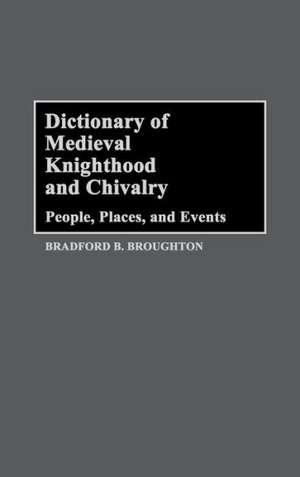Dictionary of Medieval Knighthood and Chivalry: People, Places, and Events
Autor Bradford B. Broughton Ilustrat de Megan B. Blumbergsen Limba Engleză Hardback – 31 mai 1988
A complementary companion to the author's "Dictionary of Medieval Knighthood: Concepts and Terms" (Westport, CT: Greenwood, 1986), this takes the Norman conquest of England in 1066 as its starting point and the late fourteenth century, marked by the unsuccessful revolt of the English peasantry in 1381, as its concluding point. The categories named in the subtitle encompass knights, nobles, rulers, clerics, fictional characters, literary works, chansons de geste, castles, battles, treaties, legal terms, and the authors whose works historical and fictional have transmitted the medieval heritage to later ages. Largely confining his scope to Anglo-Norman chivalry and politics, Broughton describes and analyzes the roles people, events, and places played in a colorful and bloody age. Within articles cross-references to other entries in this volume and the Concepts and Terms volume are nearly as thick as the rain of arrows from battlements during battle. This thorough cross-referencing is especially helpful to the casual reader who approaches these books without a background knowledge of knighthood and its social, political, and military dimensions. Together these two dictionaries offer modern readers the means to understand the medieval world. "Wilson Library Bulletin"
This work, a companion volume to the "Dictionary of Medieval Knighthood and Chivalry: Concepts and Terms" (Greenwood Press, 1986), is designed to help the uninitiated reader understand more easily the development and growth of chivalry and knighthood in the medieval age. Focusing primarily on people, places, and events in France and England, Broughton provides a brief biography of major historical knights and other personages of note, descriptions of important literary knightly characters and the works in which they appear, identification of castles and other places of geographical interest, and accounts of major battles during the period 1050-1400.
The entries are all arranged alphabetically, and virtually all include a reference to the primary scholarly works on the subject. Frequent cross references are made to the Concepts and Terms volume and to related entries in the present volume, enabling the researcher to find materials of interest easily. Broad in scope, the dictionary covers issues ranging from the Battle of Hastings, which brought the concept of knighthood to England in 1066, to the battle of Crecy (1346) and Poiters (1356) and the legendary Knights of King Arthur's Round Table. A significant contribution to the study of medieval history and literature, this volume will be an indispensable aid to students pursuing research in this area.
| Toate formatele și edițiile | Preț | Express |
|---|---|---|
| Hardback (2) | 314.43 lei 6-8 săpt. | |
| Greenwood – 28 feb 1986 | 328.32 lei 3-5 săpt. | |
| Greenwood – 31 mai 1988 | 314.43 lei 6-8 săpt. |
Preț: 314.43 lei
Preț vechi: 621.65 lei
-49% Nou
60.17€ • 64.34$ • 50.17£
Carte tipărită la comandă
Livrare economică 18 aprilie-02 mai
Specificații
ISBN-10: 0313253471
Pagini: 795
Dimensiuni: 156 x 234 x 43 mm
Greutate: 1.28 kg
Editura: Greenwood
Descriere
Cuprins
Dictionary of Names, Places, and Events
Appendixes: Genealogical Charts; Topical List of Entries
Bibliography
Index
Recenzii
«This is a companion volume to the book of the same title by Professor Broughton, dealing with Concepts and Terms (1986) which I have already reviewed in this journal. Like its predecessor it is handsomely produced and printed. . . . It covers the same period as the earlier volume (approximately 1050-1400 A.D.) and it too is a remarkable mine of useful information. After a helpful Introduction on the nature of chivalry and its development in Western Europe, supplementing that in the earlier volume, Professor Broughton provides entries not only up the well-known historical personages and important places which feature in th period but also on many lesser known but interesting and significant people and places. . . . I was gratified to find excellent entries on the castles of Alnwick, Bamburgh, Berwick, Dunstanburgh and Newcastle-upon-Tyne. . . . I am certain that like its predecessor, the present volume will prove to be of immense value not only to less experienced students, but also to scholars.“”The Durham University Journal












